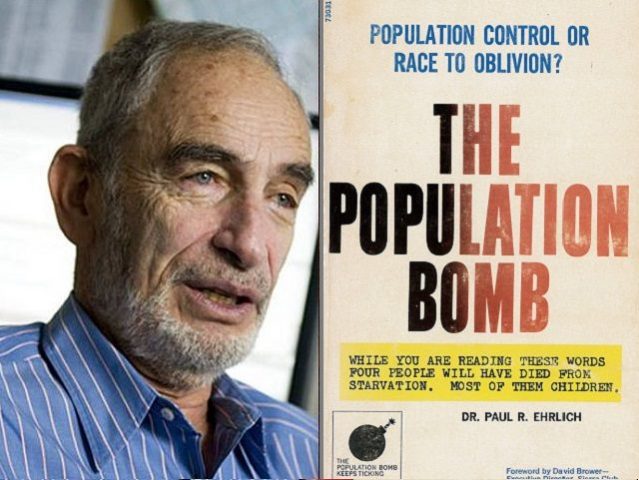Williams: The Great Population Hoax Turns 50

Father Miles Walsh Homily: Men of the Immaculata 2018 (Video)
May 2, 2018
Priests Appeal to World’s Bishops to Address ‘Pastoral Crisis’ in the Church
May 2, 2018
This month marks the 50th anniversary of one of the most destructive books of the last century, The Population Bomb, by Paul Ehrlich.
By Thomas D. Williams, PH.D., Bretibart, 1 May 2018
The 1968 doomsday bestseller generated hysteria over the future of the world and the earth’s waning ability to sustain human life, as Stanford biologist Paul Ehrlich offered a series of alarming predictions that turned out to be spectacularly wrong, creating the enduring myth of unsustainable population growth.
Ehrlich prophesied that hundreds of millions would starve to death in the 1970s (and that 65 million of them would be Americans), that already-overpopulated India was doomed, and that most probably “England will not exist in the year 2000.”
In conclusion, Ehrlich warned that “sometime in the next 15 years, the end will come,” meaning “an utter breakdown of the capacity of the planet to support humanity.”
If these musings had been received for what they actually were—the wacky theories of a crackpot academic—all would have been well. But The Population Bomb sold some 3 million copies and influenced an entire generation.
Ideas have practical consequences, and Dr. Ehrlich did not leave his followers guessing as to what they ought to be.
In the course of his illustrious career, Ehrlich has defended mass sterilization, sex-selective abortion, and infanticide. In his call for radical population control, Ehrlich has said he would prefer “voluntary methods” but if people were unwilling to cooperate, he was ready to endorse “various forms of coercion.”
To allow women to have as many children as they want, Ehrlich said, is like letting people “throw as much of their garbage into their neighbor’s backyard as they want.”
Those who had the coercive power to put Ehrlich’s theories into practice bear witness to just how horrifying they were.
To reduce its population, China instituting a draconian one-child policy, which has now left the country (through sex-selective abortions) with a horrific gender imbalance, with yearly births of some 120 boys born for every 100 girls. As a result, “30 million more men than women will reach adulthood and enter China’s mating market by 2020.”
Many nations—including the United States—began attaching population control measures to aid packages to third-world countries, meaning that the amount of aid received became conditioned by the state’s ability to coercively reduce its own population.
The tragic fact is that as a credentialed scientist—a biologist lecturing at Stanford University—Ehrlich’s proclamation of the end times as well as the means to confront them struck many as the plausible theory of an “expert.”
As Bill McGurn argues in the Wall Street Journal Monday, in his day, Dr. Ehrlich’s “assertion about the limited ‘carrying capacity’ of the Earth was settled science. Never mind that it is rooted in an absurdity: that when a calf is born a country’s wealth rises, but when a baby is born it goes down.”
A few brave souls resisted the urge to jump on the population explosion bandwagon, urging calm and rationality. One was economist Julian L. Simon, who later noted that “whatever the rate of population growth is, historically it has been that the food supply increases at least as fast, if not faster.”
In 1981, Simon published The Ultimate Resource, underscoring man’s ability to adapt to new circumstances and overcome obstacles through ingenuity and creativity. It is the human mind, rather than coal, trees, or iron, that is the ultimate resource—one that suffers no risk of depletion.
Another population expert, Fred Pearce, has more recently noted that birthrates are now below long-term replacement levels nearly everywhere, a trend he examined in his 2010 book, The Coming Population Crash and Our Planet’s Surprising Future.
The baffling mystery is how Ehrlich—despite his utterly failed forecasts—can continue to be hailed today as a serious scientist with something important to say to the world.
In early 2017, the Vatican invited Dr. Ehrlich to speak at an academic conference titled ‘Biological Extinction,” sponsored jointly by the Pontifical Academy of Science and the Pontifical Academy of Social Sciences.
The conference addressed issues of biodiversity, “great extinctions” of history, population and demographics, and Ehrlich was invited to speak on “Causes and Pathways of Biodiversity Losses: Consumption Preferences, Population Numbers, Technology, Ecosystem Productivity.”
The enduring power of alarmist theories such as Ehrlich’s, which somehow survive being exposed as utterly false, should give people pause before embracing similar theories and their practical corollaries, even when based on “settled science.”
In a 2015 article, The New York Times observed that “worrying about an overcrowded planet has fallen off the international agenda” and has now been replaced “by climate change and related concerns.”
While perhaps failing to observe the irony of its own reporting, the Times juxtaposed the thoroughly discredited population explosion theories of the 1970s with the (equally alarmist) global warming predictions of our day.
As scientists themselves are beginning to recognize, doomsday theories—including those surrounding global warming—must learn to factor in the astounding resilience of human intelligence and the ability of human beings to react to changing scenarios in remarkably ingenious ways.
Follow Thomas D. Williams on Twitter
http://www.breitbart.com/big-government/2018/05/01/williams-great-population-hoax-turns-50/




